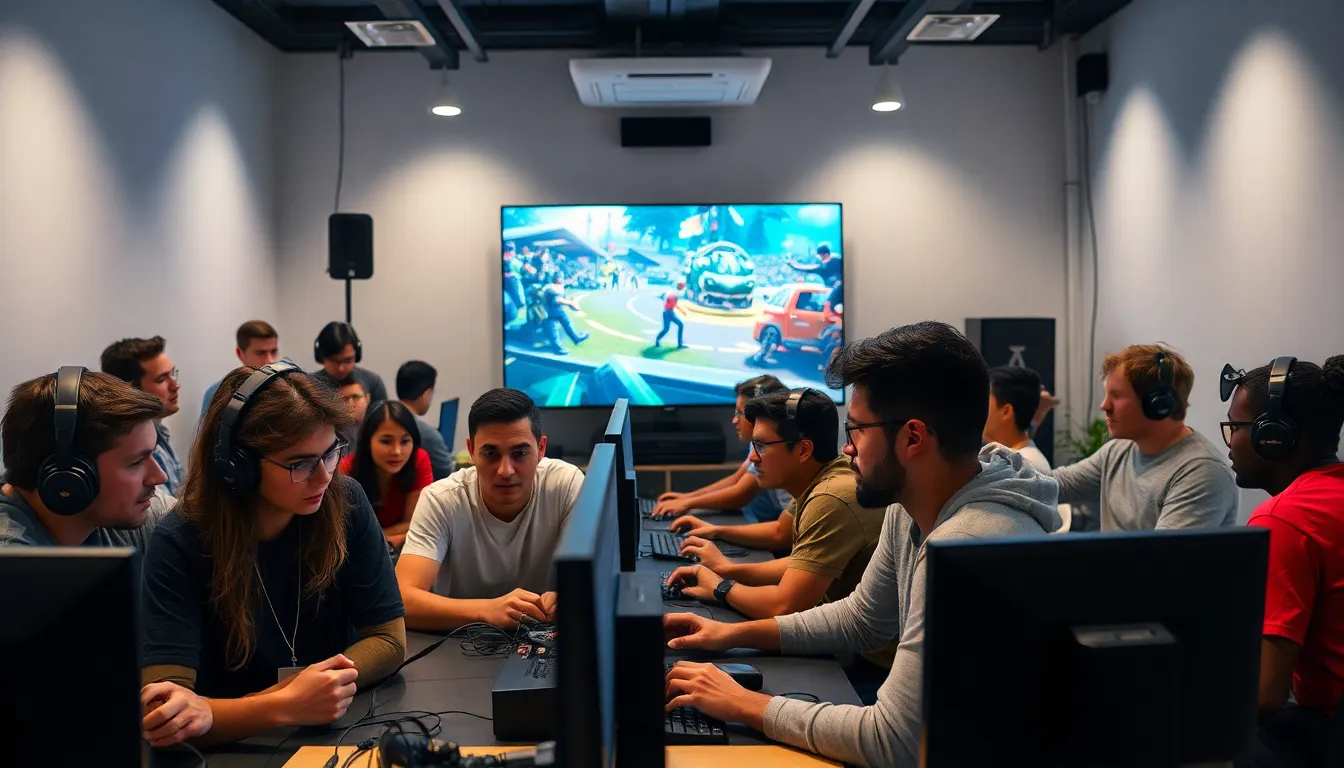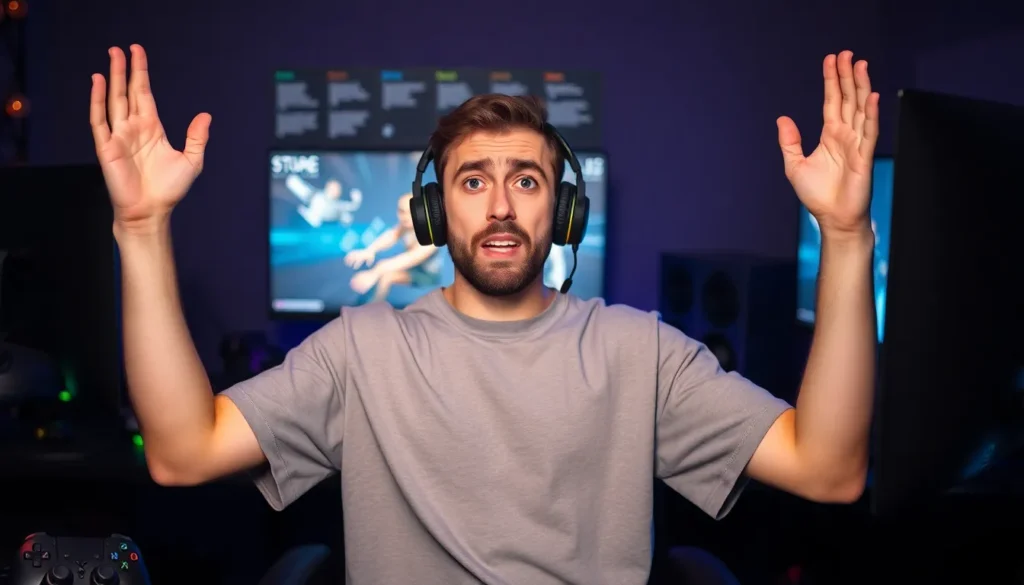In the world of multiplayer gaming, nothing’s more frustrating than a sync issue that turns a thrilling battle into a chaotic mess. Picture this: you’re about to score the winning goal when suddenly your character freezes mid-air, leaving you wondering if your internet connection is playing hide and seek. It’s enough to make even the calmest gamer throw their controller in despair.
Table of Contents
ToggleUnderstanding Multiplayer Sync Issues
Multiplayer sync issues often disrupt gameplay, affecting player experiences and engagement. These technical problems can lead to frustrating encounters in dynamic gaming environments.
Definition of Multiplayer Sync Issues
Multiplayer sync issues refer to discrepancies between player actions across different devices or networks. These inconsistencies manifest as lag, delays, or desynchronized game states, leading to unfair advantages or confusing gameplay scenarios. For example, one player may see a character perform an action while another does not, creating chaos in cooperative missions. Addressing these issues ensures that all players share a consistent game world.
Importance of Synchronization in Multiplayer Games
Synchronization plays a crucial role in maintaining a fair and enjoyable gaming experience. When synchronization is effective, players can engage in real-time interactions, enhancing the immersive quality of games. Proper synchronization ensures that player actions, game events, and environmental changes happen simultaneously for everyone involved. Without it, players may experience disrupted gameplay, resulting in losses or setbacks. Efficient synchronization minimizes frustration and builds player trust in the game environment.
Common Causes of Multiplayer Sync Issues

Multiplayer sync issues often stem from various technical factors that disrupt gameplay. Understanding these causes helps players identify potential triggers for their frustrating experiences.
Network Latency
Network latency plays a critical role in multiplayer games. Increased latency disrupts communication between players and the server, resulting in noticeable lag. Players may experience delayed actions and missed opportunities, especially during fast-paced moments. Factors contributing to latency include distance from the server and the quality of the internet connection. A stable and high-speed connection often improves synchronization, while slow connections create frustration.
Server Overload
Server overload can severely impact game performance. When too many players connect simultaneously, the server struggles to manage requests. This overload leads to desynchronized game states and increased wait times for actions to register. Many game developers implement load balancing techniques to prevent this issue, yet busy gaming hours can still overwhelm servers. In multiplayer scenarios, an overloaded server directly affects the fluidity of gameplay and overall player satisfaction.
Client-Side Variability
Client-side variability introduces discrepancies in how different devices process game data. Variations in hardware specifications cause performance differences between players. For instance, a high-quality graphics card enhances visual response, while older devices may lag behind. Additionally, individual software settings can impact performance, resulting in uneven synchronization. Consistent updates and optimized configurations on all players’ devices help minimize these variabilities and improve the multiplayer experience.
Effects of Multiplayer Sync Issues
Sync issues significantly impair the overall multiplayer gaming experience. Players often encounter disruptions that can frustrate and diminish immersion.
Gameplay Experience Disruption
Disruptions like freezes and lag interrupt gameplay pacing. Players may find that their character’s actions lag behind those of others, leading to confusion. Moments when a player attempts to execute a coordinated action may result in a chaotic experience. Lag can affect critical events, such as battles or strategic moves, creating unbalanced situations. These interruptions lead to decreased player satisfaction and can deter engagement with the game. Frequent sync problems cause a fragmented experience, making it difficult to enjoy the game’s narrative or competitive aspects.
Competitive Fairness Implications
Sync issues also create significant challenges for competitive fairness. Players competing against one another expect equal opportunities within the game environment. When discrepancies occur, one player may gain an unfair advantage while others struggle to keep pace. Such imbalances can compromise tournament integrity and ruin competitive spirit. Additionally, players may question the reliability of outcomes in matches plagued by synchronization problems. Competitive gaming relies on trust that every participant experiences the game consistently, but sync issues erode this trust. Fair competition hinges on effective synchronization, ensuring all players operate within the same virtual framework.
Solutions to Multiplayer Sync Issues
Addressing multiplayer sync issues involves several strategic solutions designed to enhance gameplay. Players can improve their experiences by focusing on optimizing network connections, enhancing server infrastructure, and utilizing advanced synchronization techniques.
Optimizing Network Connections
Optimized network connections significantly reduce lag and improve overall gameplay. Players should use wired connections instead of Wi-Fi when possible, as this can lower latency. Regularly testing internet speeds helps identify connection issues. Selecting servers closer to geographic locations ensures better performance. Also, limiting bandwidth usage during gameplay by closing background applications can enhance synchronization.
Implementing Better Server Infrastructure
Robust server infrastructure serves as a foundation for seamless multiplayer experiences. Upgrading server hardware improves performance under heavy load. Utilizing dedicated servers instead of peer-to-peer systems fosters better stability. Load balancing techniques distribute player connections evenly, alleviating server overload. Frequent maintenance schedules enhance server reliability, ensuring consistent performance during peak times.
Synchronization Algorithms and Techniques
Effective synchronization algorithms streamline communication between players and the game server. Prediction algorithms minimize perceived lag by anticipating player actions, maintaining fluid gameplay. Interpolation techniques help smooth out data inconsistencies, providing a more cohesive experience. Utilizing authoritative servers can enhance fairness by ensuring that all player actions are validated through a central point. Regular updates to synchronization methods keep pace with emerging technology, enhancing overall gameplay efficiency.
Future of Multiplayer Synchronization
The future of multiplayer synchronization hinges on emerging technologies and innovative strategies. Players expect seamless interaction and immersive experiences across varied platforms.
Advances in Networking Technology
5G technology sets a new standard for gaming connectivity. By vastly reducing latency and increasing bandwidth, it allows for smoother and more dynamic multiplayer experiences. Fiber-optic networks also enhance data transfer speeds, providing players with quicker connections. Improved infrastructure, including dedicated gaming servers, supports larger player bases without sacrificing synchronization. Developers are exploring peer-to-peer connections, which can reduce reliance on central servers and minimize lag. Enhanced network protocols optimize data packets, further increasing efficiency during gameplay.
Role of AI and Machine Learning
Artificial intelligence adds a transformative layer to multiplayer synchronization. Advanced algorithms predict player actions, helping reduce perceived latency during fast-paced moments. Machine learning models analyze gameplay data to identify sync issues in real time and implement corrective measures. These technologies enable adaptive systems that adjust settings based on player behavior and network conditions. AI can also optimize server load management, improving responsiveness for all participants. Integrating AI-driven solutions enhances the overall gaming experience, promoting a fair and engaging environment.
Multiplayer sync issues remain a significant challenge for gamers seeking seamless experiences. The impact of lag and desynchronization can frustrate players and disrupt the flow of gameplay. As technology evolves, so do the solutions to these problems. By optimizing network connections and leveraging advanced synchronization techniques, players can enhance their gaming experiences.
Emerging technologies like 5G and AI promise to further improve synchronization, paving the way for more immersive and fair multiplayer environments. Staying informed about these advancements will help players navigate potential sync issues more effectively. Ultimately, a commitment to better connectivity and innovative solutions will lead to a more enjoyable gaming landscape for everyone involved.





